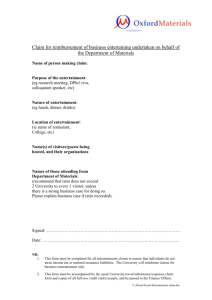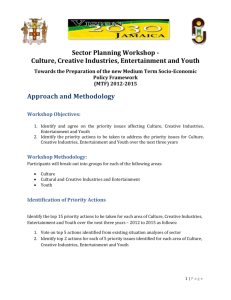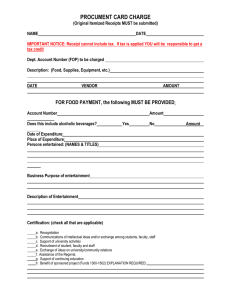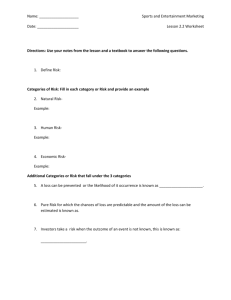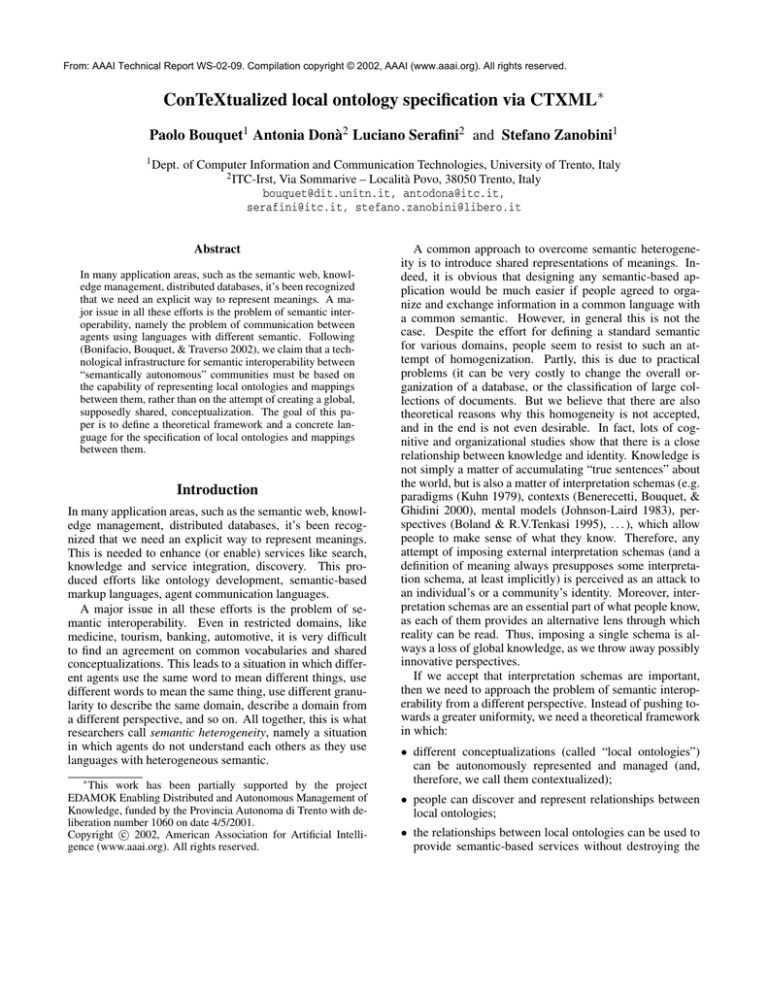
From: AAAI Technical Report WS-02-09. Compilation copyright © 2002, AAAI (www.aaai.org). All rights reserved.
ConTeXtualized local ontology specification via CTXML∗
Paolo Bouquet1 Antonia Donà2 Luciano Serafini2 and Stefano Zanobini1
1 Dept.
of Computer Information and Communication Technologies, University of Trento, Italy
2 ITC-Irst, Via Sommarive – Località Povo, 38050 Trento, Italy
bouquet@dit.unitn.it, antodona@itc.it,
serafini@itc.it, stefano.zanobini@libero.it
Abstract
In many application areas, such as the semantic web, knowledge management, distributed databases, it’s been recognized
that we need an explicit way to represent meanings. A major issue in all these efforts is the problem of semantic interoperability, namely the problem of communication between
agents using languages with different semantic. Following
(Bonifacio, Bouquet, & Traverso 2002), we claim that a technological infrastructure for semantic interoperability between
“semantically autonomous” communities must be based on
the capability of representing local ontologies and mappings
between them, rather than on the attempt of creating a global,
supposedly shared, conceptualization. The goal of this paper is to define a theoretical framework and a concrete language for the specification of local ontologies and mappings
between them.
Introduction
In many application areas, such as the semantic web, knowledge management, distributed databases, it’s been recognized that we need an explicit way to represent meanings.
This is needed to enhance (or enable) services like search,
knowledge and service integration, discovery. This produced efforts like ontology development, semantic-based
markup languages, agent communication languages.
A major issue in all these efforts is the problem of semantic interoperability. Even in restricted domains, like
medicine, tourism, banking, automotive, it is very difficult
to find an agreement on common vocabularies and shared
conceptualizations. This leads to a situation in which different agents use the same word to mean different things, use
different words to mean the same thing, use different granularity to describe the same domain, describe a domain from
a different perspective, and so on. All together, this is what
researchers call semantic heterogeneity, namely a situation
in which agents do not understand each others as they use
languages with heterogeneous semantic.
∗ This work has been partially supported by the project
EDAMOK Enabling Distributed and Autonomous Management of
Knowledge, funded by the Provincia Autonoma di Trento with deliberation number 1060 on date 4/5/2001.
c 2002, American Association for Artificial IntelliCopyright gence (www.aaai.org). All rights reserved.
A common approach to overcome semantic heterogeneity is to introduce shared representations of meanings. Indeed, it is obvious that designing any semantic-based application would be much easier if people agreed to organize and exchange information in a common language with
a common semantic. However, in general this is not the
case. Despite the effort for defining a standard semantic
for various domains, people seem to resist to such an attempt of homogenization. Partly, this is due to practical
problems (it can be very costly to change the overall organization of a database, or the classification of large collections of documents. But we believe that there are also
theoretical reasons why this homogeneity is not accepted,
and in the end is not even desirable. In fact, lots of cognitive and organizational studies show that there is a close
relationship between knowledge and identity. Knowledge is
not simply a matter of accumulating “true sentences” about
the world, but is also a matter of interpretation schemas (e.g.
paradigms (Kuhn 1979), contexts (Benerecetti, Bouquet, &
Ghidini 2000), mental models (Johnson-Laird 1983), perspectives (Boland & R.V.Tenkasi 1995), . . . ), which allow
people to make sense of what they know. Therefore, any
attempt of imposing external interpretation schemas (and a
definition of meaning always presupposes some interpretation schema, at least implicitly) is perceived as an attack to
an individual’s or a community’s identity. Moreover, interpretation schemas are an essential part of what people know,
as each of them provides an alternative lens through which
reality can be read. Thus, imposing a single schema is always a loss of global knowledge, as we throw away possibly
innovative perspectives.
If we accept that interpretation schemas are important,
then we need to approach the problem of semantic interoperability from a different perspective. Instead of pushing towards a greater uniformity, we need a theoretical framework
in which:
• different conceptualizations (called “local ontologies”)
can be autonomously represented and managed (and,
therefore, we call them contextualized);
• people can discover and represent relationships between
local ontologies;
• the relationships between local ontologies can be used to
provide semantic-based services without destroying the
“semantic identity” of the involved parties.
1995)), and contributes to define a community’s identity.
In general, different perspectives are not completely unrelated. For example, two communities may have different
viewpoints on the same domain, or have overlapping interests. Possible existing relations between different perspectives can be seen as mappings between the relative different
and autonomous conceptualizations. These mappings cannot be defined beforehand, as they presuppose a complete
understanding of the two conceptualizations, which in general is not the case. This means that mappings can be discovered dynamically. e.g. through communication, experience,
trial and error. In other words, through meaning negotiation. We are now going to describe the theoretical framework presented in the introduction with respect to such a
KM scenario.
We see meaning negotiation as the process that dynamically enable agents to discover relationships between local
ontologies. The goal of this paper is to create an “environment” in which the preconditions for meaning negotiation
are satisfied. In particular, on the one hand, we define a
theoretical framework in which local ontologies and mappings between them can be represented; on the other hand,
we provide a language for describing what we call a context space, namely a collection of contexts and their mappings; this language is called ConTeXt Markup Language
(CTXML) and is based on XML and XML-Schema. Local ontologies are represented as contexts, in the sense discussed in formal papers like (Ghidini & Giunchiglia 2001;
Benerecetti, Bouquet, & Ghidini 2000). In what follows, we
will use knowledge management as our main motivation for
contextualized local ontologies; however, as we said at the
beginning, we believe that similar motivations can be found
in any semantically distributed application, e.g. the semantic
web.
Contexts
The abstract representation of a context is a triple
c, A , R , where: c is a context identifier; A is a collection
of explicit assumptions; and R is an explicit representation.
The context identifier c is a unique identifier associated
with a context; explicit assumptions are attributes (parameter/value pairs) that provide meta-information about the context (e.g., the context owner, or its history); the explicit representation is the real content of a context, namely a conceptualization, and is represented as a labelled tree. Possible
reference models for the content of contexts can be based
on first order logics, propositional logics, description logics, general graph structures (graphs, acyclic graphs, lattices,
etc.), concept hierarchies, and so on. In this paper, we chose
to use concept hierarchies (in the sense defined in (Büchner
et al. 1999)).
Concept hierarchies are built from a set L of labels. L is
composed by two disjoint subsets:
Contextualized local ontologies in knowledge
management
Knowledge has been recognized as one of the most important assets of modern organizations. (Drucker 1994) claims
that we are entering “the knowledge era”, in which the basic
economic resource is no longer capital, or natural resources,
or labour, but knowledge.
As a managerial practice, Knowledge Management (KM)
can be described as a collection of methodologies and tools
that provide support in creating new knowledge within
the organization and codifying such newly created knowledge into “storable objects” (e.g. documents, repositories,
databases, procedures, forms).
(Bonifacio, Bouquet, & Traverso 2002) shows that in KM
we can find the same dichotomy between centralized and
distributed approaches to knowledge, and provides motivations to support a distributed approach to KM, namely an
approach that starts from the recognition that there exist autonomous communities within an organization and that technology should supports knowledge exchange not by eliminating differences, but by designing systems that will enable semantic interoperability between autonomous communities.
We assume that autonomous communities organize their
(local) knowledge according to a local ontology, i.e. a set
of terms and relations between terms, which provides a conceptualization of the piece of world which is relevant for the
objectives of that community. Examples of local ontologies
are: a set of shared directories, a taxonomy used by a scientific community, and so on. Each community (team, group,
and so on) within an organization has its own conceptualization of the world, which is partial (i.e., covers only a portion
of the world), approximate (i.e., has a degree of granularity), and perspectival (i.e., reflects the community’s viewpoint on the world). Each local conceptualization represents
a community’s perspective on the world (see for example the
concept of perspective making in (Boland & R.V.Tenkasi
1. LC (concept labels);
2. LR (relation labels).
LR is split into hierarchical (LH ) and non-hierarchical – or
general – labels (LG ).
Definition 1 (Concept hierarchy). A concept hierarchy is
a graph H = C, E, where C is a finite set of nodes, E a
finite set of directed edges between nodes, and all the nodes
and edges have a label from L, such that the edges labelled
with hierarchical labels form a tree.
We don’t put any restriction on the set LC of concept labels, whereas we require that LR = {is-a, part-of, inst-of},
where: is-a represents the subclass relation (for instance
“Cat is-a Animal”, “Man is-a Mortal”); part-of represents
the relation of being part of (for instance, “Leg part-of
Man”, “Tenor part-of Choir”); inst-of represents the fact that
a certain individual is an instance of a concept (for instance
“Paolo inst-of Man”, “Michele inst-of Tenor”).
Contexts can be given a concrete representation using different languages: XML, XML-schema, KIF, CycL, Ontolingua, DAML-OIL, RDF, RDF-schema (see (Corcho & Pérez
) for a survey on these languages). Among them, we decided
to adopt XML and XML-Schema.
2
The concrete representation of a context is an XML document composed of two main parts: the header and the content. The header is an XML document containing the following components:
Context.xsd
What
we define
in this
document
(an XML schema
for a generic
context)
Owner The owner of the context. This is important in KM
applications, as it can be used, for example, to grant permissions, and to allow users to assign a degree of confidence to a context based on their trust in the context
owner.
Group The group in which this context has been developed.
This is necessary as the owner can be a member of different groups.
Security Contains information about the access rights,
passwords, encryption, etc.
History Contains information on how a context was generated. Examples are: “from scratch”, “by combining (portions of) existing contexts”, “by copying some existing
context”.
Instance of
Context23.xml
...
<Content>
<complextype name = "article">
<attribute name = "author type="strung"/>
</complextype>
</Content>
...
Instance of
Doc23summary.xml
<article>
<author>
paolo rossi
</author>
</article>
Quantum phisics
paolo rossi
Text minimg
blaldkf;j fak
lkadflakfjd;
lakdjf;lakfa
lkajf;lkajd;fl
;lakjf;lakjdf
;lakdjf;lakjdf
lakjd;flkajd
akd alfja alkf
l alfja flla fk
sdkaljfalklk
klasd akfha
akfha kahdf a’a =
kadh aj f ajf ad
la;jdf
;ladjf
lajd ;a;dfkja f
a;lkdfja;ldfkj
Figure 1: CTXML
The content of a context is a concrete representation of a
concept hierarchy in an XML-schema. Since XML-schema
is an XML document, an XML-schema document can be included in the XML-document that describes a context. The
elements and the edges of a concept hierarchy are represented via XML-schema constructs as follows:
Entertainment
SEE_ALSO
isa
Shopping
isa
Games
partOf
1. Each node of a concept hierarchy is represented either as
a complexType or as an element. For example, the concept “Man” and its instance “Paolo” would be represented
as follows:
isa
isa
Music
isa
isa
Comics &
Animation
isa
Movies &
Films
Syn: Movies
SoundTracks
Credit Cards
instanceOf
VHS
Actors
Television
isa
isa
Education
Animation
isa
isa
Cartoons
Artists
instanceOf
Platoon O.S.T.
Stefano Accorsi
<complexType name="Man"/>
<element name="Paolo" type="Man"/>
isa
2. The relation is-a is represented via the element
extension. Thus, the relation “Man is-a Mortal” is represented as follows:
SEE_ALSO
Warner Bros
instanceOf
<complextype name="Man">
<extension base="Mortal"/>
</complexType>
Looney Tunes
Figure 2: The context structure ’Entertainment’
3. The relation part-of is represented through a combination
of the primitives element and extension. For example, to declare that “Keyboard”, “Monitor”, and “Case”
are elements of a “Personal Computer”, one can use the
following XML-schema:
<element name="NokiaAB"
type="PCMonitor"/>
In order to validate a context, we can write down a DTD,
or another XML-schema, that describes the structure of the
XML-schema for Concept Hierarchies. For uniformity reasons, we chose to express the structure of a context in an
XML-schema document. An overview of the intuition underlying the concrete representation of the content (i.e. the
explicit representation) of a context is depicted in Figure 1.
Context.xsd is an XML schema that describes the structure of a generic context; any context can be specified as
an XML document (e.g., context23.xml) of the type described by context.xsd.
<complextype name="PC">
<extension base="anything">
<element name="keyboard"
type="PCKeyboard"/>
<element name="monitor"
type="PCMonitor"/>
<element name="case"
type="PCCase"/>
</extension>
</complexType>
An example
4. The relation inst-of is represented through the primitive
element. The example shows the declaration of the fact
that that “NokiaAB inst-of PCMonitor”.
In this section we present an example of two contexts that
represent the domain of Entertainment; the conceptual struc3
Arts &
Entertainment
tures are portions of the web directory structures of two
well-known Internet search engines. The graphical representation of the two structures is shown in Figure 2 and Figure 4, respectively.
Hierarchical arcs of both context structures are not labelled by any relation, as this information is left implicit.
These relations can be guessed on the basis of the semantics of the labels of the nodes. In the pictures above,
we deliberately added relation labels as an example. Furthermore, both contexts contain a non-hierarchical relation,
called ”SEE ALSO”.
As we said, a context is represented as an XML document composed of two parts: header and content (i.e., the
concept hierarchy). The context header of ’Entertainment’
is described below, while the the concept hierarchy is represented in Figure 3. For the sake of simplicity, we chose to
report in Figure 3 only a subset of concepts and relations of
the original concept hierarchy.
isa
Newspaper
partOf
Console
isa
isa
Games
isa
Magazines
isa
isa
RELATED_TO
partOf
Cartridges
Movies
Music
SoundTracks
DVD
instanceOf
PlayStation
isa
isa
isa
On Video
Syn: Home Video
Syn: VHS
Syn: Video Tape
isa
In Theatre
IMAX
RELATED_TO
Figure 4: The context structure ’Arts and Entertainment’
hi-fi for cars” is conceptualized in the same way in the two
contexts. Nonetheless, the concepts in the two contexts are
in some relation. Of course, it is essential that we provide a
way of defining such a relation between concepts of the two
contexts (for example, to return relevant documents from a
context as an answer to a query asked in the other context).
This is achieved by introducing the idea of a context mapping. In this section we give a data structure for context
mapping.
The general intuitions behind a context mapping are the
following:
<ctxHeader ctxId="cxt01"
label="Entertainment"
add-manager="antodona"
status="draft">
<owner>
<agentId>Agent02</agentId>
</owner>
<group>
<groupId>Entertainment</groupId>
</group>
<security>
<accessRights>read</accessRights>
<encription>none</encription>
</security>
<history>
<version>v1.0</version>
<generatedFrom>
<operationType>scratch</operationType>
<elementUri/>
</generatedFrom>
</history>
</ctxHeader>
• a context mapping is directional. Indeed, we want to be
able to represent the situation in which a context c1 imports information from another context c2 using a certain
context mapping m, without forcing c2 to use the same
(or the inverse) mapping m to import the information for
context c1 .
• a context mapping should not be limited to the representation of equivalence between concepts of two different
contexts. It should allow for the representation of relations between concepts at different abstraction level. For
instance, a context mapping should be able to represent
the fact that the concept “printer” in a context is more general than the concept “laser printer” in some other context.
A mapping is a relation between a context (called source)
and another context (called
target), and
it can be formally
represented by a 4-tuple m, cs , M , ct , where m is a unique
identifier for the mapping; cs and ct are two different context
identifiers, for the source and the target context respectively;
M is the real mapping, i.e. the actual relation between the
explicit representations of cs and ct .
Let us define the abstract structure of mappings between
two context hierarchies.
Definition 2. A context mapping is a 4-tuple m, cs , M , ct ,
where:
In Figure 3, one can easily recognize a piece of XMLSchema with definitions of new complexType and element
as components of a new schema. The last part of the document is the reference to existing mappings for the defined
context:
<mappingForCtx mapId="map01"/>
The other selected context is the one of the ’Arts and Entertainment’. The concept hierarchy is depicted in Figure 4.
For lack of space, we do not provide the XML code of this
context.
1. m a unique identifier associated with a mapping;
2. cs and ct are distinct context identifiers, called source and
target context;
3. M is concept mapping from the content of the source context to the content of the target context. Where a context
mapping from a concept hierarchies Hs = Cs , Es to Ht =
Mappings
The explicit representations of two contexts can describe a
common portion of the world. For instance, a context about
“cars components” and a context about “radio and hi-fi”
might overlap on “radio and hi-fi for cars”. Despite this fact,
it is not guaranteed that the common part about “radio and
4
<ctxContent language="en">
<CHContent>
<schema xmlns="http://www.w3.org/2001/XMLSchema"
targetNamespace="http://.../entertainmentYahoo">
<complexType name="Entertainment">
<annotation>
<appinfo><label>Entertainment</label></appinfo>
</annotation>
</complexType>
<complexType name="Entertainment_Shopping">
<annotation>
<appinfo><label>Shopping</label></appinfo>
<documentation> This is the node Shopping which IS_A Entertainment </documentation>
</annotation>
<complexContent>
<extension base="Entertainment">
<element name="CreditCards" type="Entertainment_Shopping_CreditCards"/>
</extension>
</complexContent>
</complexType>
<complexType name="Entertainment_Shopping_CreditCards">
<annotation>
<appinfo><label>CreditCards</label></appinfo>
<documentation> This is the node CreditCards which is
PART_OF the node Shopping </documentation>
</annotation>
</complexType>
<complexType name="Entertainment_Music">
<annotation>
<appinfo><label>Music</label></appinfo>
<documentation> This is the node Music which IS_A Entertainment </documentation>
</annotation>
<complexContent>
<extension base="Entertainment"/>
</complexContent>
</complexType>
<complexType name="Entertainment_Music_SoundTracks">
<annotation>
<appinfo><label>SoundTracks</label></appinfo>
<documentation>
This is the node SoundTracks which IS_A Entertainment_Music
</documentation>
</annotation>
<complexContent>
<extension base="Entertainment_Music"/>
</complexContent>
</complexType>
<element name="PlatoonO.S.T." type="Entertainment_Music_SoundTracks">
<annotation>
<appinfo>
<label>PlatoonO.S.T</label>
</appinfo>
<documentation>
This is the node PlatoonO.S.T which is an
INSTANCE_OF Entertainment_Music_SoundTracks
</documentation>
</annotation>
</element>
</schema>
</CHContent>
</ctxContent>
Figure 3: XML for the concept hierarchy
5
Entertainment
Shopping
Games
Music
Comics &
Animation
Television
Movies &
Films
Credit Cards
SoundTracks
VHS
Platoon O.S.T.
Actors
Education
Stefano Accorsi
Animation
Cartoons
Artists
Less
General
Than
Warner Bros
Equivalent
Compatible
Looney Tunes
Arts & Entertainment
Newspaper
Games
Magazines
Movies
Music
SoundTracks
Console
Cartridges
IMAX
DVD
On Video In Theatre
PlayStation
Figure 5: Mapping between ’Entertainment’ and ’Arts and Entertainment’
⊥
∗
≡
Ct , Et , is a tuple of relations −→, −→, −→, −→, −→
each of which is a subset of Cs ×Ct .
target contexts, and so on); and a content, namely the actual
mapping between the explicit representations of the source
and target contexts.
Intuitively c1 −→ c2 means that c1 is more general than c2
(e.g., animal is more general than dog); c1 −→ c2 means that
≡
c1 is less general than c2 ; c1 −→ c2 means that c1 −→ c2 and
An example
Figure 5 shows a graphical representation of a subset of the
possible relations between concepts of ’Entertainment’ and
concepts of ’Arts and Entertainment’.
As contexts, mappings are represented as an xml file, instance of a defined XML-Schema, and composed by two
parts: the header and the set of relations. For the example
of Figure 5 the header is the following, while the content of
the mapping is represented in Figure 6. Note that there are
∗
examples of −→ (Less General Than), −→ (Compatible),
≡
−→ (Equivalent) relations between concepts. The definition
of all the other relation is similar except for the name.
⊥
c1 −→ c2 ; c1 −→ c2 means that c1 is disjoint from c2 (e.g.,
∗
mountain is disjoint from sea), c1 −→ c2 means that c1 is
compatible with c2 (e.g., cars are compatible with hi-fi, as
there are hi-fi for cars).
Distributed Description Logics (Borgida & Serafini 2002)
provides a basic formal framework in which multiple concept hierarchies related mappings can be described.
The concrete representation of a mapping is an XML document which structure is described by the another XMLschema. Similary to contexts, a concrete mapping is composed of two parts: a header, which contains attributes of
the mapping (e.g., an identifiers, the ids of the source and
<mapHeader mapId="map01">
<owner>
6
<mapContent>
<CH2CHContent>
<schema xmlns="http://www.w3.org/2001/XMLSchema"
targetNamespace="http://.../Yahoo2Epinions"
xmlns:ctxSource="http://.../entertainmentYahoo"
xmlns:ctxTarget="http://.../artsEntertainmentEpinions">
<complexType name="lessGeneralThan">
<choice>
<element name="pair1">
<complexType>
<sequence>
<element type="ctxSource:Entertainment" name="source"/>
<element type="ctxTarget:artsEntertainment" name="target"/>
</sequence>
</complexType>
</element>
</choice>
</complexType>
<complexType name="equivalent">
<choice>
<element name="pair1">
<complexType>
<sequence>
<element type="ctxSource:Entertainment_Games" name="source"/>
<element type="ctxTarget:artsEntertainment_Games" name="target"/>
</sequence>
</complexType>
</element>
</choice>
</complexType>
<complexType name="compatible">
<choice>
<element name="pair1">
<complexType>
<sequence>
<element type="ctxSource:Entertainment_Television" name="source"/>
<element type="ctxTarget:artsEntertainment_Movies_OnVIdeo" name="target"/>
</sequence>
</complexType>
</element>
</choice>
</complexType>
</schema>
</CH2CHContent>
</mapContent>
Figure 6: XML for mapping
7
Drucker, P. 1994. Post Capitalist Society. Cambridge University Press.
Ghidini, C., and Giunchiglia, F. 2001. Local models semantics, or contextual reasoning = locality + compatibility.
127(2):221–259.
Johnson-Laird, P. N. 1983. Mental Models. Cambridge
University Press.
Kuhn, T. 1979. The structure of Scientific Revolutions.
University of Chicago Press.
<agentId>Agent02</agentId>
</owner>
<group>
<groupId>Entertainment</groupId>
</group>
<security>
<accessRights>modify</accessRights>
<encription>none</encription>
</security>
<history>
<version>v1.0</version>
<generatedFrom>
<operationType>scratch</operationType>
<elementUri/>
</generatedFrom>
<generatesList/>
</history>
<mapSource ctxId="cxt01" ctxVersion="v1.0"/>
<mapTarget ctxId="ctx02" ctxVersion="v1.0"/>
</mapHeader>
Conclusions
In this paper we described a theoretical framework for contexts and mapping for distributed knowledge management.
We also provide a concrete language that allow to specify
contexts and mappings. In a further work (also presented to
this workshop) we have outlined the main ideas of a linguistic based algorithm for automatic discovering of mappings
between contexts.
References
Benerecetti, M.; Bouquet, P.; and Ghidini, C. 2000. Contextual Reasoning Distilled. Journal of Theoretical and Experimental Artificial Intelligence 12(3):279–305.
Boland, J., and R.V.Tenkasi. 1995. Perspective making and
perspective taking in communities of knowing. Organizational Science 6(4):350–372.
Bonifacio, M.; Bouquet, P.; and Traverso, P. 2002.
Enabling distributed knowledge management. managerial and technological implications. Novatica and Informatik/Informatique III(1).
Borgida, A., and Serafini, L. 2002. Distributed description logics.
In Horrocks, I., and Tessaris, S.,
eds., Proceedings of the 2002 Intl. Workshop on Description Logics (DL2002).
Toulouse: CEUR-WS.
ONLINE: http://CEUR-WS.org/Vol-53/, ARCHIVE:
ftp://SunSITE.Informatik.RWTH-Aachen.DE/pub/
publications/CEUR-WS/Vol-53.tar.gz.
Büchner, A.; Ranta, M.; Hughes, J.; and Mäntylä, M. 1999.
Semantic information mediation among multiple product
ontologies. In Proc. 4th World Conference on Integrated
Design & Process Technology.
Corcho, O., and Pérez, A. G. A roadmap to ontology specification language. In Knowledge Engineering and Knowledge Management. Methods, Models and Tools. Prooceedings of the 12th International Conference, EKAW 2000,
80–96.
8

